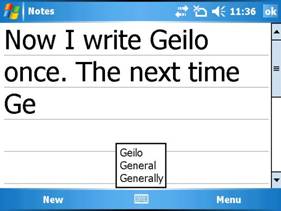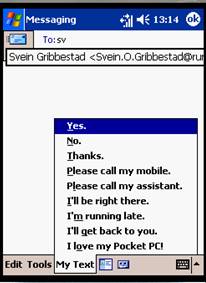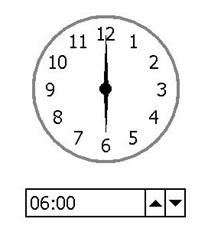|
Mechanisms for entering text
This problem stems from the problem area Handling input in the main problem area Interaction mechanisms. BackgroundThe main mechanisms for entering text on PDAs are SW keyboards, small physical keyboard and stokes-based input. Common for all built-in physical keyboards is that they are so small that the user must enter text with one or two finger. Common for most SW keyboards and all strokes-based input is that it is difficult to operate them without using the stylus. ProblemWhen designing a PDA application where the user must enter some text, there are two related problems to solve: how to avoid that the user must enter text and how to make it easier for the user to enter text. The main goal is often to avoid having to use the generic text entering mechanisms. Solutions approachesA different type of solution than the design patterns presented below is to collect data from some other source than user interaction, usually by exploiting contextual data [7, 12]. This principle is based on an assumption that the context in which a mobile user operates changes more rapidly than it does for a stationary user and that this knowledge may be used to make the application more user-friendly, i.e. obtaining data that the user would have had to enter if the application did not have this ability. An example of this is using an RF-ID sensor to identify a piece of equipment that is to be inspected so that the user is relieved from entering a long and cryptic equipment id. A related alternative to exploiting contextual data is to use multimodal input [16]. Design patternsAuto completeThis is a mechanism that tries to guess what the user is about to write and suggests this by filling in the suggested text ahead of the writing of the user, as illustrated in fig. 1 below. On the Windows Mobile platform an adaptive auto complete mechanism is included in all the generic input mechanisms. Specialized applications specific auto complete mechanisms in certain field are usually more efficient. This is common when writing an URL in most web browsers and when writing names in an email client. Common for such solutions is that they use the history of values used earlier to suggest the new ones.
Fig. 1. Auto-complete in a notes application Predefined valuesBy this we mean having a list of all (or the most common) texts to enter in a field, accessed from a menu or from a combo box, as illustrated in fig. 2 below.
Fig. 2. Using predefined answer alternatives in a messaging application Alternative input mechanismsBy this we mean using UI controls that are operated directly on the screen as an alternative to keyboard, as illustrated in fig. 3 below. In addition to radio buttons, combo and check boxes, spinners, sliders, and menus are the most common controls for this. Most of these mechanisms require that there is some sort of restrictions on the domain of the attributes that should be entered through the mechanism.
Fig. 3. Using clock and spinners for adjusting the time Specialized input mechanismsBy this we mean using (a combination of) existing controls in a new way to implement a creative solution. An example of this approach is the mechanism used in an application for service technicians, where the user may write common fault description in a natural language like syntax by choosing from a set of drop down list with commonly used nouns, verbs and preposition expressions. Having a restricted number of values in each dropdown list still facilitates entering a very large number of possible sentences in a simple way. |
|


